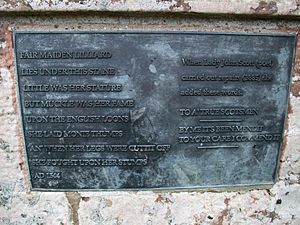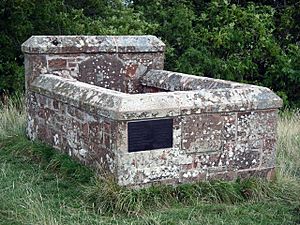Battle of Ancrum Moor facts for kids
Quick facts for kids Battle of Ancrum Moor |
|||||||
|---|---|---|---|---|---|---|---|
| Part of Anglo-Scottish Wars | |||||||
|
|||||||
| Belligerents | |||||||
| Commanders and leaders | |||||||
| Sir Ralph Eure † Sir Brian Layton † |
|||||||
| Strength | |||||||
| approx 2,500 |
3,000 mercenary Reiters |
||||||
| Casualties and losses | |||||||
| Unknown | 800 killed 1,000 prisoners |
||||||
| Designated | 21 March 2011 | ||||||
| Reference no. | BTL2 | ||||||
The Battle of Ancrum Moor was a major fight during the War of the Rough Wooing in 1545. It was a big victory for the Scots. This win helped stop the English from attacking the Scottish borderlands for a while. Today, the battlefield is a protected historic site in Scotland.
Contents
Why the Battle Happened
King Henry VIII's Plan for Scotland
As his rule was ending, King Henry VIII of England wanted Scotland to be his ally. He hoped his son, Edward, would marry the young Scottish queen, Mary, Queen of Scots. Henry tried to make this happen using both talks and threats.
Scotland's Choice
Some Scottish nobles had been captured by the English earlier. Henry tried to use them to get what he wanted. But in December 1543, the Scottish Parliament made a big decision. After much debate, they chose to say no to Henry's offer. Instead, they decided to renew their old alliance with France, known as the Auld Alliance. This alliance meant Scotland and France would support each other.
The Rough Wooing Campaign
England Declares War
King Henry VIII was very unhappy with Scotland's decision. He declared war on Scotland. This war was an attempt to force Scotland into an alliance with England. It was part of a long history of disagreements between the two countries. This conflict later became known as the "Rough Wooing".
English Attacks in Scotland
Henry ordered the Earl of Hertford to attack Scotland. Hertford followed orders, causing a lot of damage in southern Scotland in 1544. He even burned Edinburgh in May of that year.
In 1545, another English army continued the attacks. This army was led by Sir Ralph Eure. They raided many places in the Scottish Borders. One terrible event was the burning of Brumehous Tower. The lady of the house, her children, and servants were inside.
Scottish Leaders Unite
These attacks brought together two Scottish nobles who used to be enemies. They were the Earl of Arran and the Earl of Angus. Arran was the Regent, ruling for the young Queen Mary. Angus and Arran had been rivals for many years. They even fought in the streets of Edinburgh in 1520.
However, Angus's own lands were attacked by the English. He also found out that King Henry VIII had given some of his lands to Eure. Angus was furious. He famously said he would sign the land deeds with a "sharp pen and red ink," meaning with blood.
Because of this, Scottish politics were put aside. Arran and his rival, Mary of Guise, made peace with the Earl of Angus. Angus and his brother, George Douglas of Pittendreich, were forgiven for their past actions with England. This happened at the Scottish Parliament in December 1544.
The Scottish Army Gathers
The Scottish army first had between 300 and 1,000 horsemen, called "lances," led by Angus. There were also troops from Fife led by George Leslie, 4th Earl of Rothes and Norman Leslie. Later, Scott of Buccleuch and his Borderers joined them. Scott's lands had also been destroyed by Eure. Together, they marched to face the English army near Jedburgh.
The Battle of Ancrum Moor
The English Army
The English army was made up of about 3,000 German and Spanish soldiers who fought for money. They also had 1,500 English Border Reivers led by Sir Brian Layton. Plus, there were 700 Scottish Borderers who had agreed to fight for England.
The Scottish Trap
The English army set up camp near Gersit Law. A small group of Scottish soldiers pretended to attack, then quickly ran away. They retreated southwest towards Palace Hill. A large part of the English army chased after them.
As the English soldiers crossed the top of Palace Hill, they found a surprise. The entire Scottish army had been hidden on the other side of the hill. The Scots had the advantage of surprise. Also, the setting sun was behind them, shining into the eyes of the English. The wind blew gunpowder smoke from the Scottish guns towards the English.
The Scottish Charge
Scottish soldiers with long pikes charged forward. They pushed the English back in confusion. The Scottish pikes were longer than the English ones. This meant the Scots could hit the English before the English could hit them.
The ground was too rough for the English to regroup at the top of Palace Hill. As they tried to rally again on the eastern slope, something important happened. The Scottish Borderers who were fighting for England suddenly changed sides. They tore off the red crosses that showed they were with England. They went back to fighting for Scotland. The English army broke apart and ran away through the countryside.
Regent Arran Visits the Battlefield
After the battle, Regent Arran came to the field. He congratulated the Earl of Angus on the victory. He asked a prisoner to point out the body of Sir Ralph Eure. Arran reportedly cried and said, "God have mercy on him, for he was a very cruel man. Many people and children without fathers suffered because of him. It is sad that such killing and bloodshed should happen among Christian people."
Scottish writers of the time also mentioned Arran's visit. They said he gave thanks for the unexpected win. A small number of Scots had defeated a much larger and well-equipped army. This was a rare event, especially for a winter battle.
What Happened Next
The English lost about 800 men who were killed. This included Eure and Layton. Another 1,000 English soldiers were taken prisoner. This victory temporarily stopped the English attacks on Scotland.
News of the Scottish win also made Francis I of France send troops to help the Scots. However, these French troops did not achieve much. The war ended soon after King Henry VIII died. But the conflict started again with even more fighting. This happened when Hertford, now ruling for Edward VI, tried to force his own plans on Scotland.
Fair Maiden Lilliard
There is a monument at the battle site, also called Lilliard's Edge. It has a traditional poem carved on it:
Fair maiden Lilliard
lies under this stane
little was her stature
but muckle was her fame
upon the English loons
she laid monie thumps
and when her legs were cuttit off
she fought upon her stumps.
- AD 1544
This monument was put up in the 1800s. But it replaced an older stone with the same words. The story says Lilliard fought in the battle after her loved one died. However, her story is a legend. The name of the place was recorded as "Lillesietburn" in the 1100s and "Lillyat Cros" in 1378. This shows the name was there long before the battle. The poem itself is based on an older English folk song called Chevy Chase.



